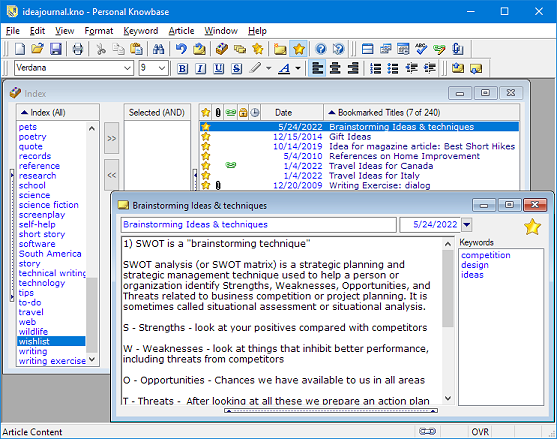Creating an Idea Dump with Personal Knowbase
Whether you're an entrepreneur, a writer, an artist, an inventor, a programmer, or anyone doing creative work, your ideas are your first step toward developing your projects. Your ideas are a valuable resource and critical to your productivity. Treat them as they deserve — with loving care.
Using Personal Knowbase notes management software as a central repository for your ideas keeps them together, makes it easy to find related ideas, and provides a structure for browsing your undeveloped ideas. Collect and organize all of your inspirations into PK articles and index them with keywords so that you can retrieve related ideas later.
Why Keep an Idea Dump
 It's easy to get in the habit of recording your ideas all over the place as you think of them. On scraps of paper on your desk and in drawers. On a whiteboard. In a journal. In numerous text files in different folders on your hard drive. As voice memos on your phone. As emails that you send yourself.
It's easy to get in the habit of recording your ideas all over the place as you think of them. On scraps of paper on your desk and in drawers. On a whiteboard. In a journal. In numerous text files in different folders on your hard drive. As voice memos on your phone. As emails that you send yourself.
Writing your thoughts down as soon as possible is wise. But if you don't bring them together into one location, you'll have trouble finding scattered notes later when you need them. You'll remember that you had an idea about how to deal with an issue, but you may not remember when or where you captured it.
A better solution is to organize your undeveloped ideas in one place. Yes, this takes a little extra effort. But once you get in the habit of collecting them into one system, you'll save time and energy later when you're looking for a thought that you know you wrote down somewhere.
“Having a place for ideas... combined with the habit of free-form recording of those ideas, guarantees a great deal of valuable thinking that wouldn't otherwise occur.” ~ David Allen
What to Include in Your Idea Dump
Don't let your ideas get away from you. Record anything that you might want to develop later. It's better to have too many ideas than too few. Some seeds may never mature into full plans, but it's hard to tell at the moment of inception what will grow and what won't.
In addition to actual ideas, include things that you run across that inspire you. For example, you could include:
- web clippings that spark ideas
- interesting events you experience or witness
- dreams that spark your imagination
- projects that you started which stalled
Problems with Paper-based Systems
Many writers and other creatives like to use a "idea journal" notebook in which they record ideas sequentially on the next available page. Others use scraps of paper in manila file folders.
Using a software system to store ideas solves many of the problems of using a paper-based system. Some serious limitations of paper-based systems include:
- You can't search for text.
- You have no backup if something happens to it.
- You can't easily connect items.
- The sheer volume of entries can become unmanageable over time.
Additional problems specific to linear notebook systems include:
- The linear format precludes keeping related thoughts together as they occur over time.
- You can't shuffle or reorganize the contents to find new associations or keep related items together.
- Deleting or modifying entries involves crossing out or writing in margins which makes your journal messy and difficult to read.
- Pages can wear out or even tear out.
Recording Ideas in Your Dump
Capture the ideas that come to you at odd times as soon as possible. Many people keep a notebook or some scrap paper nearby for this purpose so that they can immediately capture brainstorms while watching TV, eating dinner, waiting for their oil change, or wherever. Consider using your phone's voice recorder or a stand-alone ICR voice recorder to verbally capture your mental images when paper is not an option, such as while driving or hiking.
Save these bits of paper or voice recordings for processing. As soon as possible, copy the information into Personal Knowbase. When possible, do it that same evening while it's still fresh. While typing, let your mind run with it if you have the time. You may be able to develop the concept further on the spot.
I try to clear the processing pile on my desk every evening, including paper notes and voice recordings. I enter the notes into the Personal Knowbase article related to that topic. Any idea that I've developed more gets its own article.

Selecting Keywords for Your Dump
Assign keywords to your articles so that you can group related items by later selecting that keyword.
Here are some suggestions for keywording your ideas so that you can browse for specific types of entries later:
- subject matter or topic (cars, pets, college, travel)
- sources of inspiration (dreams, web, books, magazines)
- type of project (for art, for example: painting, sculpture, performance)
- category for a business concept (invention, marketing, networking)
- status of the idea (whether it's a seed or well-developed)
Using Your Dump
When you're ready to develop work on a particular project, check your idea dump for previous thoughts that you've captured about that topic.
Also review your idea bank regularly. Use it to give your creative subconscious raw material to work with. Occasionally, set aside some time to sort, evaluate, gather more data, and analyze. See what sparks.
Your ideas are valuable. Save them.
Search Site
Recent Posts
About
Personal Knowbase is a note management program for Windows. Organize free-form text information using keywords.
To see if Personal Knowbase is right for you, please download a fully-functional 30-day software trial.
Tags
attachments backup clipboard dates documentation education export files find formatting getting started import information management installation interface keywords network PK Reader portability print query registration reports research security settings site info small business support time management upgrade Windows writers